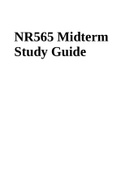NR565 Midterm Study Guide 565 Midterm Study Guide Week 1 •Drug Schedules -Descriptions of each schedule •Examples of drugs in each schedule:
-Schedule I: high potential for abuse: heroin, lysergic acid diethylamide (LSD), marijuana (cannabis), 3,4-methylenedioxymethamphetamine (ectstasy), methaqualone, and peyote.
-
-Schedule II: high potential for abuse, potentially leading to severe psychological
or physical dependence. These drugs are also considered dangerous; combination products with less than 15 milligrams of hydrocodone per dosage unit (Vicodin), cocaine, methamphetamine, methadone, hydromorphone (Dilaudid), meperidine (Demerol), oxycodone (OxyContin), fentanyl, Dexedrine, Adderall, and Ritalin
•
-Schedule III: Moderate to low potential for physical psychological dependence; producets containing less than 90 milligrams of codeine per dosage unit (Tylenol with codeine), ketamine, anabolic steroids, testosterone
Shedule IV: Low potential for abuse and low risk of dependence; Xanax, Soma,
Darvan, Darocet, Valium, Ativan, Talwin, Ambien, Tramadol
Schedule V: low potential for abuse and contain limited quantities of certain narcotics; antidiarrheal, antitussive, and analgesic purposes.
(focus on schedule 2,3, and 4 per tutor) •Which ones can and cannot be prescribed by nurse practitioners? -Prescriptive Authority Understand what prescriptive authority is and who mandates it. : Practice authority and prescriptive authority together are described as practice “enviornments” according to state laws and regulations. oFull-practice scope: Nurse practitioners have the autonomy to evaluate patients, diagnose, order and interpret tests, initiate and manage treatments and prescribe medications, including controlled substances without physician oversight . oReduced-Practice scope: Nurse practitioners are limited in at least one element of practice. The state requires a formal collaborative agreement with an outside
health discipline for the nurse practitioner to provide patient care.
oRestricted practice scope: Nurse practitioners are limited in at least one element of practice by requiring supervision, delegation, or team management by an outside health discipline for the nurse practitioner to provide patient care. ▪What problems arise when prescriptive authority is limited? Limited prescriptive authority creates numerous barriers to quality, affordable, 1 565 Midterm Study Guide and accessible patient care. For example a requirement to obtain the physician’s cosignature on prescription can increase patient waits. •Know the responsibilities of prescribing : The ability to prescribe medications is both a Privilege and a burden. The best way to keep your patients and yourself safe is to be prudent and deliberate in your decision making process. Have a documented provider-
patient relationship with the person for whom you are prescribing. Do not prescribe for family or friends or for yourself. Document a thorough history and physical examination
in your records. •Know patient reasons for medication non-adherence: -Forgot to take it
-Ran out
-Was away from home
-Was trying to save money
-Didn’t like the side effects
-Was too busy
-The medicine wasn’t working
•Know how what type of evidence prescribers should use to make treatment recommendations: -
•Be familiar with physiological changes of aging that impact pharmacological treatments: -Drug accumulation secondary to reduced renal function
-Polypharmacy (the use of 5 or more medications daily) -Greater severity of illness
-Presence of comorbidities
-Use of drugs that have a low therapeutic index (e.g., digoxin)
-Increased individual variation secondary to altered pharmacokinetics
-Inadequate supervision of long-term therapy
-Poor patient adherence
-
•Be familiar with Beer’s Criteria : The Beers Criteria include five lists that describe certain medications and situations and include:
-Potentially inappropriate Medication (PIM) use in older adults
-Potentially Inappropriate Medication (PIM) use in older adults due to medication-disease or medication-syndrome interactions that may exacerbate the disease or syndrome
-Medications to be used cautiously in older adults.
-Clinically significant drug interactions that should be avoided in older adults
-Medications to be avoided or dosage decreased in the presence of impaired kidney function in older adults
- •
•
•
•
•
2




